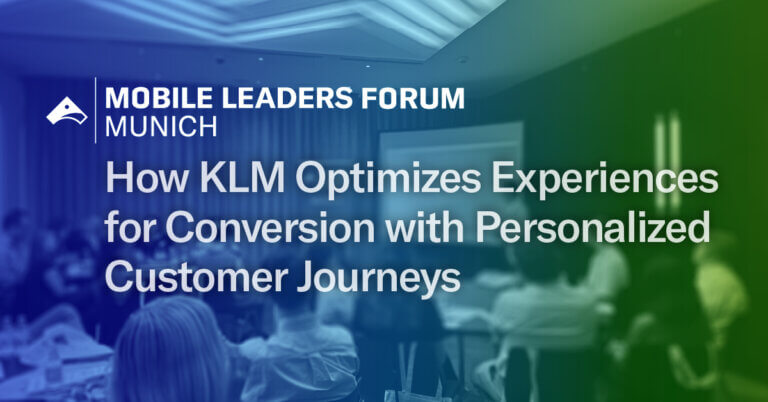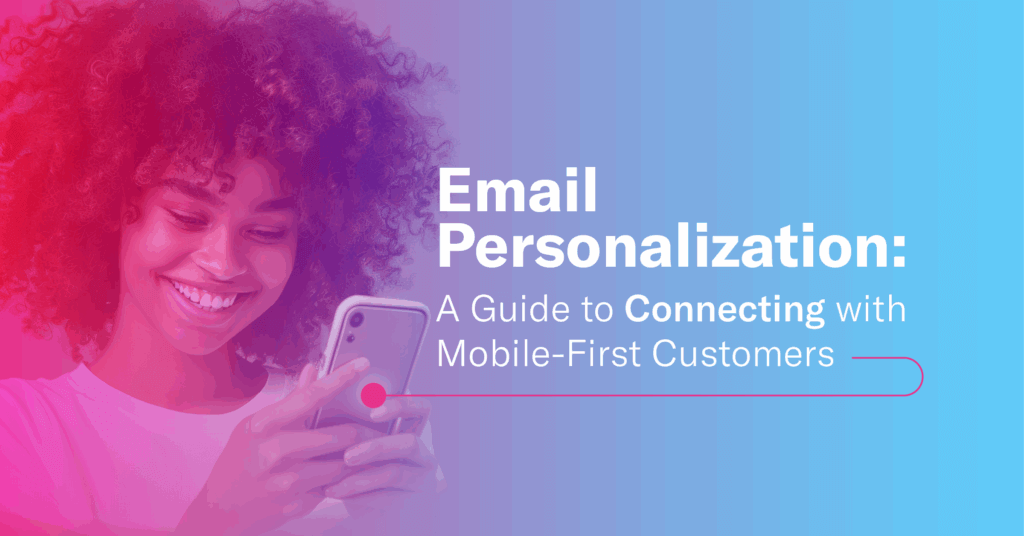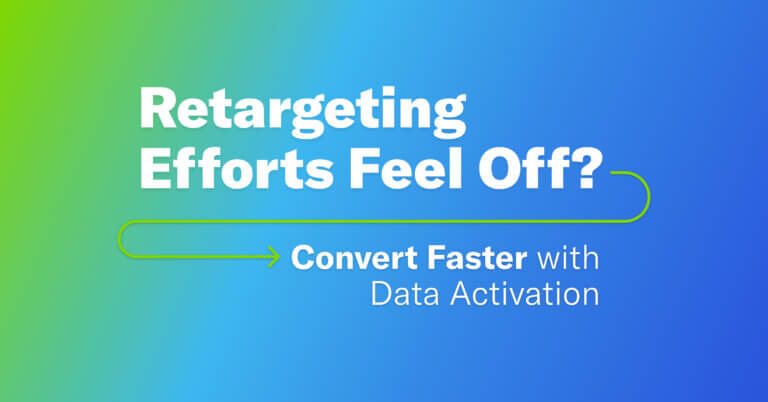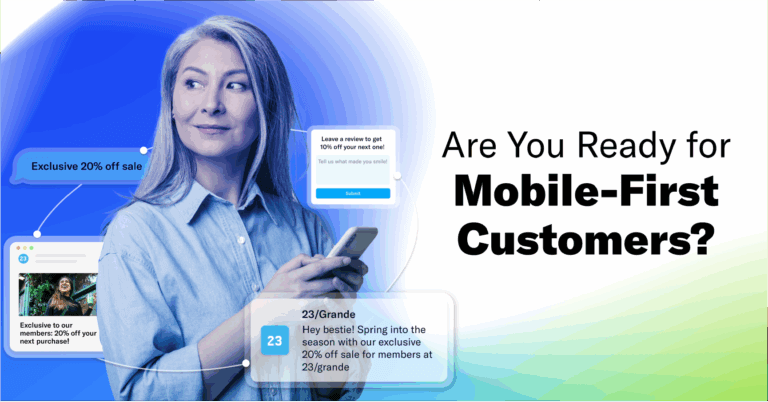
Email Personalization: A Guide to Connecting with Mobile-First Customers

Abbie Baxter Content Marketing Manager, Airship

Share to my network
In this article
Categories
Book a meeting
Connect with our team of experts to discuss your conversion and loyalty goals, and how we can help you achieve them faster.
Book a meetingEmail personalization has advanced leaps and bounds in recent years, going far beyond a first name in the subject line. Behavioral insights, dynamic content, micro-segmentation, send time optimization and more have raised the bar on what it means to offer truly individualized experiences — not only in email, but across all channels and destinations.
Yet digital fragmentation and declining access to reliable customer insights have raised new challenges in email personalization — and it’s hampering reach and impact. Airship research shows that 79% of the consumers ignore or delete marketing emails from brands they’ve subscribed to half the time or more. This is a clear call to action.
While the majority of consumers say email is their preferred communication channel with brands, your inbox placement won’t matter if the email doesn’t offer tailored value. That’s why we’ve put together this guide — to share everything you need to master email personalization and ensure every send counts toward engagement and conversion.
What Is Email Personalization?
Email personalization is tailored outreach that targets a subscriber’s behavior, preferences, context, location or purchase history. Unlike a batch-and-blast generic email sent to every subscriber on your list, personalized email campaigns are relevant to each recipient so that every note feels like it was written just for them.
It should feel like walking into your favorite coffee shop and the barista greets you by name, asks if you want “your usual” and mentions a special on the pastry you were eyeing the previous day.
The Big Trends Impacting Email Personalization
We can’t talk about email personalization without addressing some of the major trends impacting the space right now. Here’s a quick snapshot:
New Mailbox Features Change Brand Visibility
Gmail, Apple Mail and others have evolved the way that emails are presented in the inbox and how they are consumed. For example, Apple Intelligence inbox summaries highlight priority content for customers with generative summaries. Relevance is everything to maintain visibility in the inbox. Otherwise, you risk getting deprioritized by the algorithms.
A Keen Focus on Privacy is Evolving Data Collection
Increased focus on privacy requires brands to retool how they leverage customer data to personalize content and understand the impact of their email campaigns. The good news? Consumers are more open than ever to sharing zero-party data, including interests, intentions, opinions, in exchange for personalized experiences from the brands they love. A mutual value exchange — one that reflects their preferences and real-time context — is a must.
Customers Expect Seamless Cross-Channel Experiences
Email strategies often operate in silos, failing to acknowledge where customers are in their journey and what’s happening across other touchpoints. This often results in fragmented or repetitive experiences that lead to frustration, drop-off and even churn. An email should build on every prior interaction or drive customers to the next best action with consistent personalization no matter where a customer chooses to engage.
Email Personalization Wins Big with Mobile-First Customers
Checking email is an ingrained habit — a routine part of our day, much like scrolling through social media or checking the news — and, more often than not, occurs on mobile. If you’re not designing for mobile-first customers in your email marketing strategy, you’re missing out on a huge opportunity to keep customers engaged throughout the entire customer lifecycle.
After all, customer confidence isn’t granted; it’s meticulously built from the ground up through consistent and reliable value. Experience is a core pillar of building confidence, with every touchpoint in the customer journey reinforcing or eroding it.
The Building Blocks of Email Personalization
Successful email personalization starts first-and-foremost with the right framework to build experiences around the customer, rather than the channel itself.
Know When Customers Want to Be Engaged on Email
Capturing where your customers want to be engaged, when and how often is imperative. This step is often overlooked, but can make a huge difference in building trust with customers. Each channel offers a unique advantage and not everyone wants to receive the same content everywhere.
An app or web Preference Center is the best way to gather your customers’ communication preferences. With these insights, you can integrate your emails more seamlessly into customers’ lifestyles and reach them when they will be most receptive to them.
Connect Data From Across Channels & Destinations
While it may seem easier to look at customer interactions within the confines of a single channel, you will build a richer and more holistic understanding with a strategy that’s informed by every touchpoint they have with your brand, across app, website, SMS, push notifications and more. Converting anonymous browsers into known users — ideally during the activation lifecycle phase — allows you to stitch together preferences and behaviors across the entire customer journey.
Enrich Your Customer Data
Capturing and activating first- and zero-party data doesn’t stop at initial data collection points. It’s essential to keep your understanding of customers current. Great experiences incentivize customers to share more data as their needs and interests change, which in turn allows brands to serve them better over time. Interactive elements like quizzes and surveys or even gamification facilitate data collection while providing value to the customer.
Segment with Intention
Like customer behaviors and preferences, segmentation is dynamic and requires an agile approach to keep a close pulse on what resonates with each group and how membership evolves over time. Behavioral Targeting, for example, empowers you to analyze different tiers of customers based on their recency, frequency and monetary behaviors and deliver experiences tailored to exactly where they are in their journey with your brand.
Make It Dynamic
Your customers expect content that is relevant to their immediate situation and feels tailored just for them. That’s where dynamic personalization comes in, leveraging real-time data to tailor and deliver content when customers will be most receptive to it. Contextual awareness — location, device type, time of day, current browsing behavior and even weather — paves the way for hyper-relevant content and a customized email marketing experience.
Scale & Optimize with AI
Look to AI to create, scale and optimize email efforts. You can generate different content variants – everything from subject lines and preheaders to body copy and imagery – tailored to subscriber segments or optimize send times for when they will be most engaged. This allows you to accelerate time-to-value and coordinate email with other channels in your mix based on your unique goals.
Every email campaign should be a growth experiment — designed to zero in on your most effective strategies so you can allocate time and budget where it will have the most impact.
Look Beyond Engagement Metrics
Traditionally, brands have focused on optimizing for engagement, such as opens and clicks, in email. While these metrics can reveal information about a particular message or interaction, they fail to showcase the quality of that interaction or its impact on the customer’s overall journey.
More often than not, your email strategy doesn’t exist in isolation. So your customer likely moved from email to another channel to continue their journey with your brand. This means you need to go beyond open rates and clicks to measure conversions and loyalty, bringing greater focus on the holistic customer relationship rather than isolated interactions.
Real-World Examples of Email Personalization to Inspire Your Strategy
You don’t just have to take our word for it. We’ve pulled together examples from brands reaping the rewards of these strategies. Bring one or several of these ideas to your next strategy session.
ASDA Boosts Loyalty Program Engagement with Dynamic Email Content
Asda, one of the largest supermarket chains in the UK, set out to seamlessly integrate dynamic content into email narratives, illustrating each customer’s total earnings and activity throughout the year. By unifying email outreach with in-app messaging and push notifications to reinforce a seamless experience, the supermarket drove a 39% increase in email conversions.
Carrefour’s Real-Time Data Streaming Delivered Localized Product Recommendations
Carrefour struggled to ensure its recommended products were in stock at local stores. To resolve this, Carrefour combined real-time contextual data with cross-channel orchestration to deliver the most up-to-date information and promotions via email based on their location. The results? Double the engagement with personalized content over generic content, and a 50% increase in customer satisfaction due to improved relevance.
bol’s Strategic Zero-Party Data Collection Drives Hyperpersonalized Offers
When online marketplace bol saw a decline in app downloads and opt-ins, the brand encouraged customers to share their interests in products and, in turn, receive exclusive alerts across their preferred channels — email included — when those products were discounted. By tailoring offers to explicit needs, bol tripled their opt-in rates.
More Resources to Master Email in the Mobile Era
We’ve curated a selection of additional content to help you hone your strategy and maximize the effectiveness of one of the most important channels in every brand’s mix today:
- 10 Re-Engagement Email Examples to Win Back Customers & Grow Revenue
- Transactional vs. Promotional Email: What to Know to Make Every Message Count
- The Role of Email Marketing in a Cross-Channel Customer Experience Strategy
If you’re interested in implementing any of the above strategies, reach out to our team for a personalized consultation. We love to chat about email.

